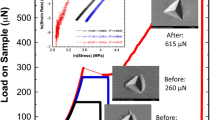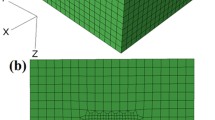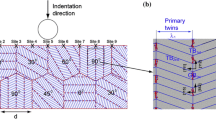Abstract
A new method has been developed to achieve a better understanding of submicron indent-induced plastic deformation. This method combines numerical modeling and various experimental data and techniques. Three-dimensional discrete dislocation dynamics simulation and the finite element method (FEM) were used to model the experimental conditions associated with nanoindentation testing in fcc crystals. Transmission electron microscopy (TEM) observations of the indent-induced plastic volume and analysis of the experimental loading curve help in defining a complete set of dislocation nucleation rules, including the shape of the nucleated loops and the corresponding macroscopic loading. A validation of the model is performed through direct comparisons between a simulation and experiments for a nanoindentation test on a [001] copper single crystal up to 50 nm deep.
Similar content being viewed by others
References
W. C. Oliver and G. M. Pharr, J. Mater. Res. 7, 1564 (1992).
M. V. Swain and J. Menčik, Thin Solid Films 253, 204–211 (1994).
S. Field and M. V. Swain, J. Mater. Res. 10, 101 (1995).
S. V. Hainsworth, H. W. Chandler, and T. F. Page, J. Mater. Res. 11, 1987–1995 (1996).
T. Y. Tsui, W. C. Oliver, and G. M. Pharr, J. Mater. Res. 11, 752–759 (1996).
A. Bolshakov, W. C. Oliver, and G. M. Pharr, J. Mater. Res. 11, 760 (1996).
W. W. Gerberich, S. K. Venkataraman, H. Huang, S. E. Harvey, and D. L. Kohlstedt, Acta Metall. Mater. 43 4, 1569–1576 (1995).
W. Zielinski, H. Huang, S. Venkataraman, and W. W. Gerberich, Philos. Mag. A 72 5, 1221–1237 (1995).
W. Zielinski, H. Huang, and W. W. Gerberich, J. Mater. Res. 8, 1300 (1993).
C. Robertson, S. Poissonnet, and L. Boulanger, J. Mater. Res. 13, 2123 (1998).
T. A. Michalske and J. E. Houston, Acta Mater. 46 2, 391–396 (1998).
C. L. Kelchner, S. J. Plimpton, and J. C. Hamilton, unpublished.
M. C. Fivel, C. F. Robertson, G. R. Canova, and L. Boulanger, Acta Mater. 46 17, 6183–6194 (1998).
L. P. Kubin, G. R. Canova, M. Condat, B. Devincre, V. Pontikis, and Y. Bréchet, Solid State Phenom. 23&24, 455 (1992).
L. P. Kubin and G. R. Canova, Scripta Metall. Mater. 27, 957 (1992).
M. Fivel, M. Verdier, and G. Canova, Mater. Sci. Eng. A 234– 236, 923–926 (1997).
M. Fivel, Doctoral thesis, INP Grenoble, Laboratoire GPM2, 1998.
D. F. Bahr, D. E. Kramer, and W. W. Gerberich, Acta Mater. 46 10, 3605–3617 (1998).
A. B. Mann and J. B. Pethica, Appl. Phys. Lett. 69 7, 907–909 (1996).
J. Lépinoux and L. P. Kubin, Scripta Metall. 21 6, 833–838 (1987).
N. M. Ghoniem and R. J. Amodeo, Solid State Phenom. 3&4, 377–388 (1988).
I. A. Polonsky and L. M. Keer, Proc. R. Soc. London A 452 1953, 2173–2194 (1996).
F. Seitz, Adv. Phys. 1, 43 (1952).
J. Friedel, Dislocations (Pergamon Press, New York, Oxford, 1964).
J. P. Hirth and J. Lothe, Theory of Dislocations, 2nd ed. (John Wiley and Sons, New York, 1982).
E. Tadmor, M. Ortiz, and R. Phillips, Philos. Mag. A 73 6, 1528–1536 (1996).
H. Hertz, J. reine Angewandte Mathematik 92, 156 (1882).
R. De Wit, Phys. Status Solidi 20, 575–580 (1967).
K. Yasuda, K. Shinohara, M. Yamada, M. Kutsuhara, and C. Kinoshita, J. Nucl. Mater. 187, 109–116 (1992).
K. L. Johnson, Contact Mechanics (Cambridge University Press, 1985).
R. Hill, The Mathematical Theory of Plasticity (Oxford University Press, 1950).
D. Tabor, Philos. Mag. 74 5, 1207–1212 (1996).
Author information
Authors and Affiliations
Rights and permissions
About this article
Cite this article
Robertson, C.F., Fivel, M.C. A study of the submicron indent-induced plastic deformation. Journal of Materials Research 14, 2251–2258 (1999). https://doi.org/10.1557/JMR.1999.0301
Received:
Accepted:
Published:
Issue Date:
DOI: https://doi.org/10.1557/JMR.1999.0301




